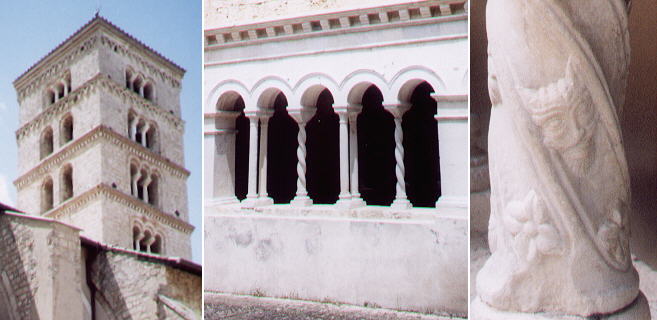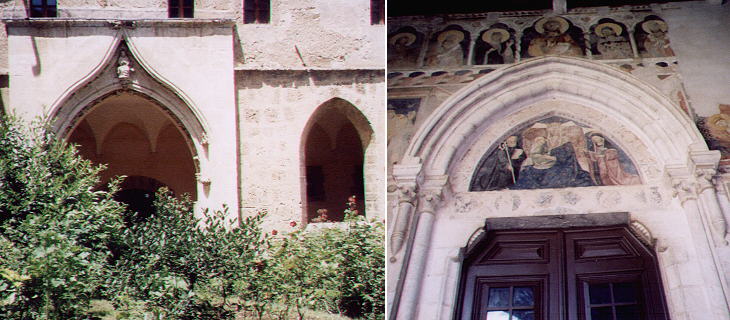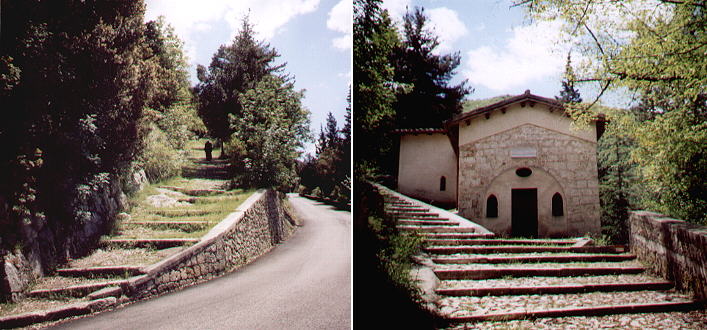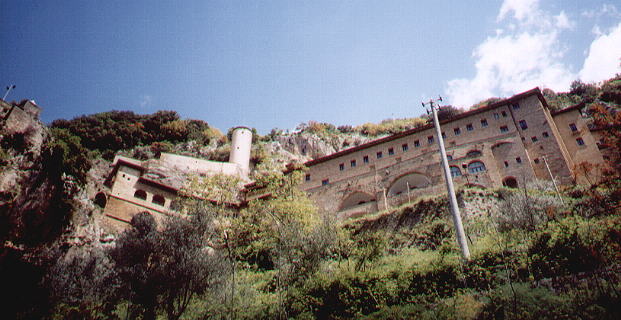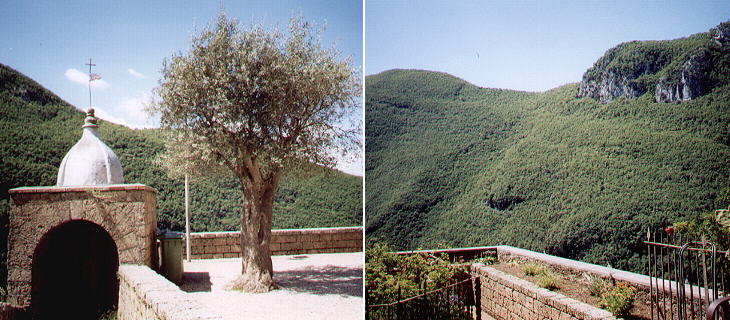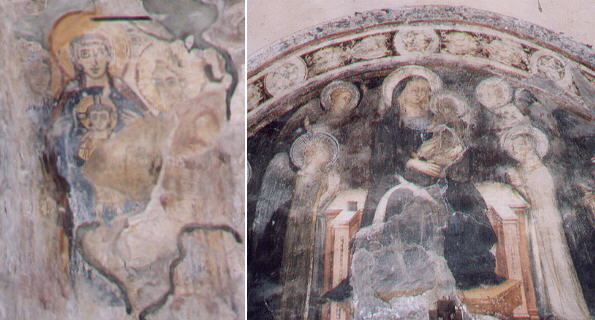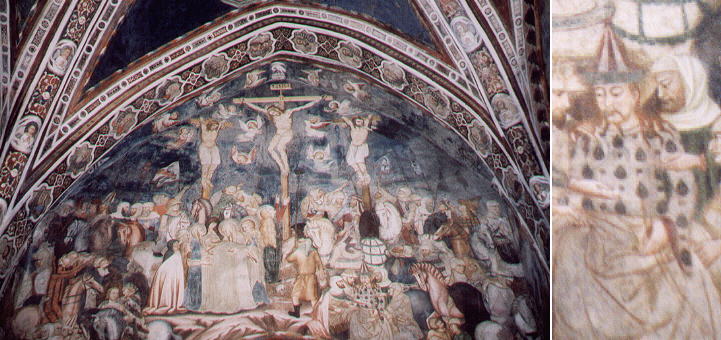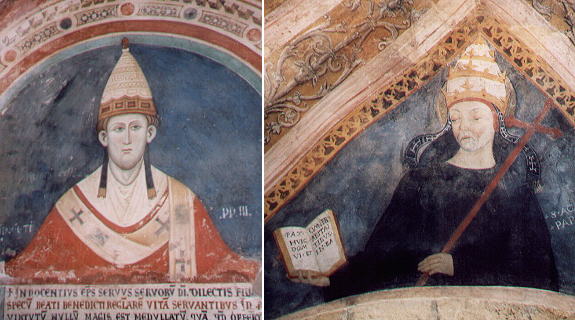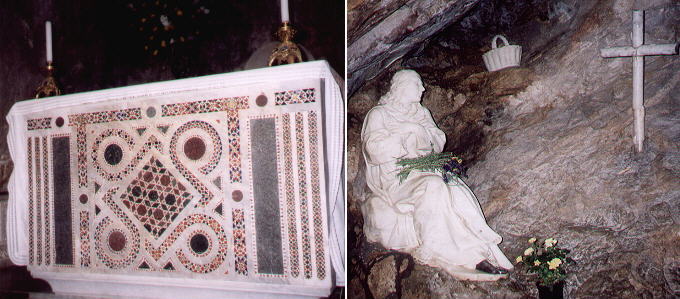  Ferdinand Gregorovius' Walks - Subiaco: the monasteries
S. Scolastica is a complex of buildings which includes three monasteries, a church, a hostel for pilgrims and a library which contains copies of the
first books printed in Italy in 1465. They were printed by the Germans Arnold Pannartz and Conrad Schweynheim who set
in the monastery a printing press. In the last page of their books they wrote Deo Gratias (Thanks God) the traditional
words by which the amanuenses celebrated the completion of their work. They did not get along too well with the monks however and a few years
later they moved their printing press to Palazzetto, later on Palazzo Massimi.
S. Scolastica has undergone many changes and it was damaged during WWII, so it suffers from an excess of different styles and periods. Its most ancient parts are the bell tower and the cloister to the left of the church which is a Cosmati work. As it often occurs in medieval works of art, there are some puzzling details.
In the cloister preceding the church there is a rather unusual (in Italy) flamboyant Gothic arch. It was most likely designed in the XVth century by a German monk. The portal of the church is Gothic too, while the interior is a late XVIIIth century work.
A modern road leads very close to the monastery of S. Benedetto (Sacro Speco), but those who are not in a hurry may prefer to reach S. Benedetto by a picturesque track flanked by chapels.
The monastery was built at various stages immediately above the cavern where the saint lived. The slope of the mountain is very precipitous at that point and the monastery is compared to a swallow's nest after a similar remark was made by Pope Pius II. The rocks above the building are almost threatening it and a statue in the courtyard portraying a Benedictine monk in the act of stopping the mountain is both a reference to a miracle and a sort of reassurance to the monks who still live in the monastery (it is the image used as a background for this page). The view is very similar to that of the monastery of Sumela, near Trebizond in Turkey.
Notwithstanding the fact that the monastery is only few hundred yards inside the valley it still enjoys views of untouched woods and mountains. The presence of olive trees is a sign that the climate even in winter is relatively mild (the monastery faces southwards). Nature helps in creating an appropriate atmosphere of peace and spiritualness. The entrance to the monastery is located at its upper end (the same thing occurs in Sumela) and the first rooms one sees are the last to be built and decorated. Ideally the visitor should try to go directly to the oldest part of the monastery which is located below the entrance. A small garden which served as cemetery for the monks is an excellent starting point for visiting the monastery following a chronological order.
Almost every inch of the two churches which can be visited is covered with paintings. In a cavern where the saint preached to the shepherds there is the oldest fresco of the monastery. It is painted directly on the rock and it is thought to be an VIIIth century work. By going up through the series of chapels which form the Lower Church one sees many XIVth century paintings of the Siena school.
The Upper Church is composed of just one nave, but it has the appearance of a church. Of the many frescoes which decorate it, the Crucifixion shown above is particularly impressive: it is worthy to note that the Jews are dressed in Arab or Turkish costumes of the XIVth century.
The portrait on the left (Pope Innocentius III 1198-1216) may not immediately attract the attention of a foreign visitor, but it surely attracts that of the Italians as they saw this portrait in their history books at school (a Briton would have the same reaction when seeing the portait of Henry VIII by Holbein). The painting is interesting also because it shows the papal crown as it was in the XIIIth century. The portrait on the right shows a pope of the VIIth century, but the XVth century painter did not care about historical accuracy and Agatho I, who died in 681, is crowned with a very nice triregno, the triple crown introduced by Bonifatius VIII (1294-1303).
In addition to its many paintings the monastery has also other interesting works of art. The altar of the Upper Church is a fine Cosmati work. The actual cavern where the saint lived for three years contains the only Baroque touch of the monastery. Antonio Raggi, a scholar of Bernini, is the author of this attempt to bring back to life the saint. His raptured young man does not follow the traditional iconography of a hermit: it is rather another version of Bernini's S. Teresa. The basket is a reference to the basket used by the saint to receive food from the local shepherds. Click here to visit the official website of the Benedictine monasteries of Subiaco. Click here to see the monasteries in the 1905 paintings by Alberto Pisa. Introductory page on Ferdinand Gregorovius Other walks: Roman Campagna: Palestrina Genazzano Paliano Anagni The Ernici Mountains: Ferentino Alatri The Volsci Mountains: Valmontone Segni Norma Cori On the Latin shores: Anzio Nettuno and Torre Astura Circe's Cape: Terracina San Felice The Orsini Castle in Bracciano See my Home Page on Baroque Rome or my Home Page on Rome in the footsteps of an XVIIIth century traveller |
All images © 1999 - 2004 by Roberto Piperno. Write to romapip@quipo.it
